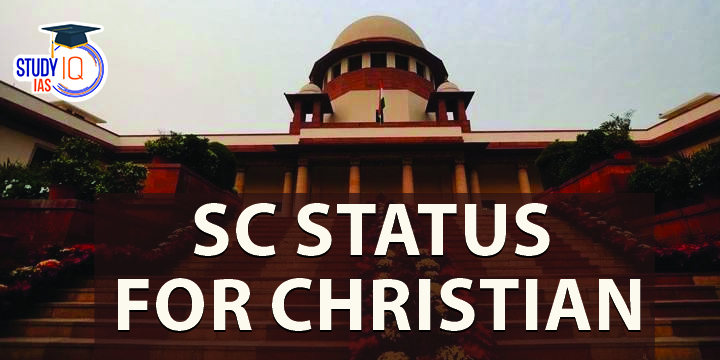Table of Contents
Scheduled Castes: Background
- Constitution Order 1950: Only Hindus were recognised as Scheduled Castes under the Constitution (Scheduled Castes) Order of 1950.
- Amendment to Constitution Order 1950: Added Dalits who had converted to Sikhism in 1956 on the recommendations of the Kaka Kalelkar Commission in 1955 ;
- Added Dalits who had converted to Buddhism in 1990, on the recommendations of the High-Powered Panel (HPP) on Minorities, Scheduled Castes and Scheduled Tribes in 1983.
- Union government Stand on Christian as SCs: In 2019, the SC rejected the possibility of including Dalit Christians as members of SCs.
- Imperial Order of 1936: Classified a list of the Depressed Classes and specifically excluded “Indian Christians” from it.
- Office of the Registrar General of India (RGI) and then National Commission for Scheduled Castes Status and Scheduled Tribes had previously recommended against Christian inclusion in SC’s category.
| Argument for Inclusion | Argument for Exclusion |
|
|
About Scheduled Castes
- 2011 Census places the number of Scheduled Castes Status in India at 16.6 percent of the total population, or approximately 166,635,700 people.
- Constitution provides for the protection of the rights of Scheduled Castes Status under several provisions.
- Article 15 of the Constitution says the State shall not discriminate on the basis of caste, religion, race, or place of birth.
- Article 16 of the Constitution also assures equal opportunity to all citizens for employment in any office under the State, including in promotions, without any discrimination based on caste.
- Article 46 of the Constitution also states that the State shall promote the educational and economic interests of weaker sections, namely “Scheduled Castes and Scheduled Tribes.”
- Article 243D provides for reservation for Scheduled Castes and Scheduled Tribes in Panchayats in the same proportion as the population of Scheduled Castes or Scheduled Tribes in the village.
- Article 243T promises the same proportionate reservation of seats in Municipalities.
- Article 330 promises reservation for Scheduled Castes and Scheduled Tribes in the Lok Sabha, once more, on a proportional basis to the total population of SC/STs to overall population.
- Article 335 assures that the claims of members of the SC/ST community [to these seats], while ensuring the efficiency of administration, shall be taken into consideration while making appointments to services and posts in connection with the State.
- Article 338 establishes the National Commission for the Scheduled Castes.
- Article 340 gives the President the power to appoint a commission to investigate the conditions of backward classes, the difficulties they face, and make recommendations on steps to be taken to improve their condition.
- Article 341 of the Constitution gives the President the power to notify which castes in the country, and in specific states, come under the category of Scheduled Castes.
- Only members of marginalised communities practising Hinduism can be deemed Scheduled Castes, according to the Constitution Scheduled Castes Order, 1950.
- The Ministry of Social Justice and Empowerment publishes a state-wise list of castes that fall into the schedule, and only those people carrying certificates of caste from the listed states qualify for the protections afforded to members of the SC community.


 DRDO and Air Force Successfully Test Ind...
DRDO and Air Force Successfully Test Ind...
 IB ACIO Recruitment 2025 Notification Ou...
IB ACIO Recruitment 2025 Notification Ou...





















